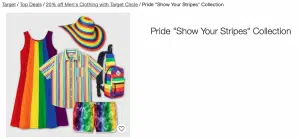
Queer coding originated through hinted queer characters presented in cinema without being allowed to be labelled as queer / CREDIT: Lgbtqhistory.org
An effective way for one to safely identify as queer, a need-to-know coded language through fashion has expanded through out the years.
Dr. Claire Senior is a professor of Language and Liberal Studies at Fanshawe. In her variety of teachings, one particular course is an emphasis on LGBTQ+ issues and history with secrecy.
Senior comments the simplicity of Queer Coding can be regarded to “Hey, I like your jeans.. Wink wink.” With cuffed jeans being a notable trend in today’s queer fashion aesthetic.
Queer coding is nothing new, but has evolved through out the decades through popular ways of hinting through fashion.
“The queer community had to operate with so much secrecy for many, many years. There was a long time where fashion was this secret code for queer people. Using covert ways to signal that you belonged to the community. Gay men used to carry handkerchiefs in their back pocket to help indicate their sexual preferences.”
Additionally with queer coding, Senior touches on the conversation of ‘queer baiting’ with fashion presentation. “You’ve seen celebrities in the last couple of years, who are kind of seizing upon what they see as this trend. Someone like Harry Syles, who is hailed as this queer icon for wearing these gender non-conforming outfits, critics wonder is this guy queer baiting or is he actually apart of the queer community, and he is very coy about that. Isn’t he just a straight dude who attracts queer people as fans by not actually being queer himself? Senior, in the likes of many, reflect on queer baiting as insidious.
An additional issue revolving queer aesthetic, is how straight people perceive queer people. Queer coding originated through hinted queer characters presented in cinema without being allowed to be labelled as queer .
“A subtextual character is represented in the media but is not clearly identified by means of their sexuality. They are not explicitly described as queer, but there are clues within the work that they could be identified as such. For a long time because of the various restrictions, particularly in film with the Hays Production Code, there was no homosexuality. Screen writers then had to work really hard to hide things, and it manifested itself into an exaggeration of certain traits that straight people thought queer people possessed, and that wasn’t good.” Characters that were reoccurring related to ‘The sissy’, a feminine and exaggerated version of a gay man without directly identifying as gay.

Floyd: “Queer people tend to have a more eclectic taste” CREDIT: Jess Gould / XFM News
Although the trends of queer coding change with decades, Josh Floyd identifies with the LGBTQ+ community and notices the hints in today’s queer culture.
“There are indicators. I’d say that queer people tend to have a more eclectic taste, their style tends to follow counterculture. I would say that they co-opt punk aesthetics and things that go against the narrative.” shared Floyd. “Non-binary men dressing in dresses or skirts just to go against what’s expected of them, or men wearing crop tops typically seen as a feminine thing, things like that just going against the grain because they’ve already done it so much in their life that I think they want to express that through the clothing that they wear.”
The manifestation of over exaggerated presentation of queer people can be linked to the outflow of rainbows and merchandise Senior regards as ‘tacky’ during pride month.
“What it does, is it dehumanizes gay people to the point where I think all of the straight people can go ‘Oh, there is nothing to fear here, it’s just rainbows’, the commercialization is getting very cynical.” Senior recalls Target as being one of the many stores criticized for a hyper fixated look on queer presentation involving rainbows, unicorns, and glitter.
“I’ve never worn a rainbow in my life. It’s really in the past decade they started to appear with pride month. There’s something really non-threatening with rainbows, and I think that’s really what’s behind it. I don’t know too many gay people who wear them. The stuff Target was doing was insane. It was so over the top and garish and tacky.”
Floyd notices ally communities are more commonly found to have pride flags than LGBTQ+ members themselves.

Target’s Pride Collection with an outpour of rainbows CREDIT: Target
“Using pride flags is more for the people who support those communities than it is for the people in the communities themselves. Queer people use the pride flags more on pins that they wear on themselves that’s another subtle thing. So it’s not extremely overt, but it lets you know that ‘Hey, I’m trans’ or ‘Hey, I’m bisexual’ so you know that there’s someone in the community. I don’t think I’ve seen any queer person wear or have pride colours just because I think they’re comfortable enough with their own sexuality that they don’t need a flag to symbolize their entire orientation.”
In searching for a firm definition of queer coding, Senior calls the meaning “nebulous and hard to define”.
Queer coding can be signalled through minimalistic or grand efforts in presenting one’s self to the world, while going beyond fashion.
“It’s not really a style per say because I don’t think that there is a uniform way of presenting oneself. It’s more of a philosophy of how you present oneself. There are some people who dress flamboyantly, and everything they wear is chosen with a great deal of ‘That’s right, look at me, I’m out I’m proud’.”





Comments